JAXA Astronaut Activity Report, September, 2012
Last Updated: November 21, 2012
This is JAXA's Japanese astronaut primary activity report for September, 2012.
Astronaut Noguchi participates in the CAVES training

Noguchi and the other "Cavenaut" participants (Credit: JAXA/ESA-V. Crobu)
From early to mid-September, astronaut Noguchi participated in the Cooperative Adventure for Valuing and Exercising human behaviour and performance Skills (CAVES) training, held on the island of Sardinia in Italy by the European Space Agency (ESA).
Including Noguchi of JAXA, a total of six astronauts and cosmonauts from all participating agencies of the International Space Station (ISS), ESA, NASA, the Canadian Space Agency (CSA), and Russia, participated in CAVES.
Through about one week of co-habitation and execution of the mission in the cave on the island of Sardinia, the training aims to procure essential abilities required to execute ISS long-duration missions, such as leadership and self-management, as well as teamwork and communication skills transcending the boundaries of cultural or empirical differences.
In the cave, participants are isolated from the outside world, and cohabitate with minimal privacy, a similar environment to that of space flight. The only supplies and food are what they bring themselves. When moving around in the cave, careful attention to safety is required, as if performing Extravehicular Activity (EVA) on the ISS. Moreover, there is no way to sense the passage of time given the lack of sunlight, hence an artificial light is used to simulate day and night.


Training in the cave (Credit: JAXA/ESA-V. Crobu)
As for the preparation, from September 2 to 7, Noguchi and the participants reviewed the overview and purpose of the training. They learned all the skills required for the exploration, including the topographical features of the cave, how to update a map, obtain scientific samples, and take photos under artificial light, and rock-climbing and swimming to move around in the cave. Safety rules and how to respond to contingencies were also confirmed.
Subsequently on September 8, the participants started training. During the six-day mission in the cave, they explored, set up camp, measured inside the cave, created a map, performed a geological survey, collected microbe samples, acquired meteorological data, took photographs, and tested communication hardware.
After emerging from the cave on September 13, they cooperatively organized the data and samples obtained, discussed the training, and held a debriefing, concluding the training.
- CAVES(ESA website)
Astronaut Yui participated in the National Outdoor Leadership School

During NOLS training (Credit: JAXA)
Astronaut Yui participated in the National Outdoor Leadership School (NOLS) held in Alaska, U.S., together with NASA and ESA astronauts.
NOLS is outdoor training in a severe environment, similar to that of the ISS stay, to help the participants understand and acquire self-management and teamwork skills such as leadership and followership, as well as decision-making depending on circumstances.
Yui and the other participants traveled and camped among Prince William Sound with kayaks and improved their ability necessary for the ISS long-duration stay.
Astronaut Onishi trained for SSRMS operations

Onishi simulates SSRMS operation (Credit: JAXA/CSA)
From September 9 to 21, astronaut Onishi visited the CSA, the developer of the ISS Mobile Servicing System (MSS), for training.
MSS is composed of the Space Station Remote Manipulator System (SSRMS), the Mobile Base System (MBS), which is a base platform for SSRMS, and the Mobile Transporter, which enables SSRMS to move on the ISS truss. Through lectures and a simulator, Onishi deepened understanding of these systems.
During the two weeks of training, Onishi practiced basic SSRMS operations, grappled an object and transferred it elsewhere in the first week. In the final week, he trained in readiness for any anomaly on an SSRMS system and received training in the grapple of the H-II Transfer Vehicle (HTV) KOUNOTORI.
As part of the anomaly training, Onishi had the opportunity to learn more about the system, executing a scenario whereby the computer which controlled SSRMS failed and switching to a backup computer.
Further, Onishi repeatedly practiced operations involving grappling KOUNOTORI with SSRMS when it reached the closest point to the ISS. Initially, he started by capturing KOUNOTORI when almost still, and then increased the difficulty by adding some movement to KOUNOTORI. Sometimes KOUNOTORI was moved significantly intending to recreate various scenarios, which forced Onishi to decide whether to abort the capture at his discretion.
Onishi is scheduled to receive training to qualify as an SSRMS specialist at the Johnson Space Center (JSC) in Houston, U.S.
Astronaut Furukawa Appeared at the JAXA Symposium 2012

Furukawa speaks at a session (Credit: JAXA)
Astronaut Furukawa appeared in a session entitled "People who pioneer space - astronaut Hoshide flies to space" as one of the sessions of the 2012 JAXA Symposium held in Fukuoka city on September 19 and Sapporo city on September 21.
Pakkun Makkun, the comedy duo, chaired the session. The duo introduced astronaut Hoshide's mission on the ISS and the results of medical experiments Furukawa performed while on board the ISS. The audience got excited, and offered many interesting questions such as "What can we do in everyday life to prepare for a stay in space in the near future?"
In the final words of the session, Furukawa yelled to the audience "Have interests in various things and try to reach your dreams step by step, I think most dreams will come true."
New Astronauts at the Front-Line

The NOLS (National Outdoor Leadership School) training I had this time was conducted by travelling on the Alaskan sea by kayak. I was looking forward to the training as I had heard about this type of training from those who had already experienced one to the effect that "the weather is comfortable, and the training is fun." But those foregoers went through the training at some times during the months from June through August. And it was the first time for NASA to implement the training in September!
It is cold in September in Alaska! After spending in the heat of Houston at 37 degrees Celsius every day, I felt as if it was winter in the weather of 5 degrees Celsius with cold rain poring day after day (Actually, pieces of ice were floating on the sea). The sea condition also was rough most of the days, and we could carry out the training only a few days. Fortunately, however, on the day when we travelled a long distance (about 20 km) by kayak, I had the opportunity to experience being a leader. I am now going to write about what I learned from it.
The day I served as a leader was virtually the last training day when a boat was scheduled to come to pick us up the next day. Due to rough weather during the training period, we had so far only one while-day of kayak training. When I checked the weather forecast the day before, it said the weather would get better briefly on the last training day. So I went to bed with a little expectation. But...I woke up next morning only to find it still raining hard. Getting up earlier than others, I checked the latest weather forecast. It said that the weather's recovery was just slower than expected and that a brief recovery on the day is still likely. While wondering if it was true, I decided to wake others up at a scheduled time. It seemed, however, that those not knowing the weather forecast details were thinking it hardly possible to make a long-distance travel under the day's weather condition, and their morale was apparently not high. Since weather recovery was expected only for a limited period of time and therefore we needed to move taking advantage of such a window of opportunity, I told every participating member the next meeting time and instructed to complete individual preparations for departure.
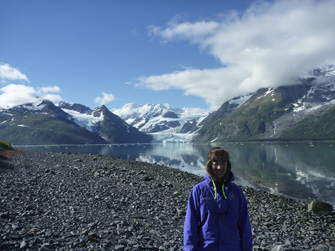
I wish we had always had weather as good as the one in this photo. But that would give us little training effects. The truth is that we should be grateful when we encounter any difficulty saying "thank you for giving us the difficulty to overcome."
A while later, we were meeting to make a decision regarding whether to make a travel as scheduled or to stay put. There are a variety of measures to make a group decision in general. As the members of the meeting had a good grasp of what should be done, I thought it would be desirable to hear the opinion of each member and make a decision while acquiring the consent of every member. After I briefed them on the day's weather forecast, the scheduled travel, and the alternative plan in bad weather, I said:
"It's raining right now. But considering today's weather forecast and the sea observation results, it is considered possible to proceed with the scheduled travel. However, I feel that everybody's morale is seemingly not very high. It will be a long-distance travel with may uncertain factors. And lower morale may invite another risk. Whether to carry out the scheduled travel, or to stay put here?--I would like to hear your frank opinion."
As anticipated, the members had a variety of opinions, which seemingly was making it not easy for us to come to a unanimous decision. Someone said: "The objective of the training we are having this time is to improve teamwork. We should be able to improve teamwork by doing other activities here as we have been doing heretofore, should we?" As a matter of fact, I myself, as the leader of the day, would find it easier to stay put and therefore have less things to make decisions on. Another member said, however, that "we are here to improve teamwork through kayak training, not through spending the day by talking in the tent." Yes, indeed! After that remark, positive opinions toward travelling gradually increased. When all opinions had been put forth and exhausted, everybody was looking at me in the face. I mustered my courage and said, "Let's take on a difficult challenge! Baggage loading starts at 09:30" to make members begin the final preparations.
However, the weather did not recover as I expected by the time immediately before departure. Rather, the wind was blowing even stronger at that time. The members looked a little worried as well. So I told them: "The weather conditions are not as good as forecasted, but the sea is not rough to the extent of being dangerous. Why don't we try going as far as we can? We have many alternative plans ready at hand." And then we departed. (To tell you the truth, I myself was worried, but it is important to speak cheerfully without letting the worry show on my face.)
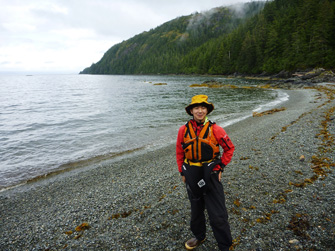
Being drenched all the time, I always tried to wear a smile on my face, because I thought I would become happy or miserable depending on my mental attitude.
Having proceeded this far, all the members raised their morale high, as they all had experiences of going through their respective tough challenges. They positively followed my directions while helping me in various ways. Although I had a mountain of things to do as leader, such as reading of a map, calling for a break, taking measures against hypothermia, giving directions on the travelling formation to take, and deciding on the next camp point, I did not feel much hardship. And what is more, we successfully arrived at the final point as planned, even earlier than scheduled (we rowed kayaks, however, as many as four to five long hours that day).
In this single day, I really had much to learn. What I realized from the most interesting experience of all is that we occasionally may forget the original objective and come close to take an easy way out, and we astronauts are no exception to it. Humans may have a propensity "to continue the same thing as before" and "to justify the choosing of an easier way out by cooking up some plausible excuses." In such a situation, it is very difficult to say something or make some decision against the existing flow. However, it is true that after such difficulty we can reap a harvest that matches the extent of the difficulty. Actually I felt the members' eyes toward me changed between before and after that day. The members seemed to be enjoying a sense of fulfillment of successful completion as well.
When delivering a speech, I always say "Difficulties make us grow. Choose a hard path when you waver in your choice." In this training session I could put that word into practice on my own and get fruits of it, for which I feel a sense of fulfillment and a little relief now. I often talk big in a speech and on Twitter while thinking myself as being presumptuous in my heart. If my deeds did not match my words, however, they make no sense and I would not be trusted by anyone.
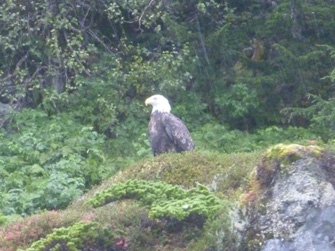
An eagle came to see us during this training session! (It was a turtle that came to see me when I was in NEEMO training.)
There was a day long before when I was called an eagle driver...
* Photo by courtesy of JAXA.

On October 5th, as you may already have seen this news on TV or something, it has been decided that my fellow astronaut Kimiya Yui is assigned to an ISS expedition. In its commemoration, I am going to describe about Mr. Yui here in this month's column. Since we, a trio of astronauts who joined JAXA in 2009, are not known well enough to the general public, I would like to inform you of some little-known facts about Mr. Yui through my introduction of him.
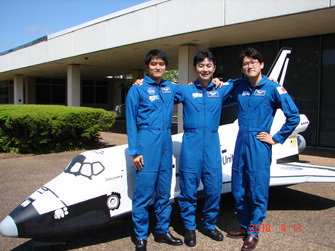
Mr. Yui, Mr. Kanai, and me were selected in an astronaut candidate selection examination conducted between 2008 and 2009 by JAXA and joined JAXA. So we are fellow workers or DOUKI in Japanese (employees who joined the company in the same year) with one another. It may be presumptuous of me, though, to call him a fellow colleague of mine since Mr. Yui is much senior to me both as a pilot and as a working member of society (sweat drop).
A respectable senior fellow, a dependable fellow worker, a friend who often plays with me in private...Mr. Yui has such various sides to me.
It was the end of the year 2008 when I met Mr. Yui for the first time. The selection examination had entered its second phase, and we were in a dinner party that was planned by some examinees of the second-phase test as a get-acquainted meeting. There were many pilots in attendance in the selection examination and I had heard that a test pilot of the Japan Self-Defense Force was among them. That pilot was Mr. Yui.
When it comes to a pilot of the Self Defense Force, I would imagine a tough-looking guy with macho muscles, but my first impression of Mr. Yui I actually saw was very gentle and friendly, with not particularly piercing eyes but rather sleepy eyes (grin). To put it bluntly, he looked as an ordinary guy who may be encountered anywhere (sorry for my rudeness!).
Assuming such a look of an ordinary guy, Mr. Yui showed significant leadership skills by taking command of a team with prominent leadership in the final selection stage. That event left a vivid impression on my memory. In whatever situation, he grasps the essence of things definitely, distinguishes between what is necessary and what is not for the team at the moment, and exerts strong leadership in a group. So Mr. Yui would come to play a leading role almost spontaneously in many cases during the long period of the final selection examination. It may be an open question whether leadership skills are a person's innate skills or those acquired through training, but it seems to me that the confidence Mr. Yui got after undergoing intense training in the Self Defense Force lies as a foundation under his style of leadership.
Then, after we went over to Houston, USA and came to join training for astronaut candidates conducted by NASA, there was this incident:
Those days I could barely follow lectures with my inadequate English ability. Feeling anxious, I just wondered to what extent Mr. Yui understood the lecture and once asked him about it. Mr. Yui 's answer was "it will suffice if we understand this part, this part, and this." I was shocked. Even Mr. Yui may not have been able to hear and understand all of the lecture completely, but it was amazing that he could sort out which parts of the lecture were important, or conversely speaking, which parts were not so important. More importantly, the words by Mr. Yui gave me an unexplainable sense of assuredness like magic that I had to understand only those parts.
There are many other episodes that illuminate how amazing Mr. Yui is, but praising him sky-high may be uninteresting. So I would tell you the personal and human aspects of Mr.Yui the perfect superman.
Mr. Yui dislikes vegetables as he admits and as recognized by others as well. And it seems that he has his own persistence regarding meals because he has a fixed menu item to order for each restaurant he goes. When we had just moved to America, we would often go out to eat since we were both singles. In a Chinese restaurant we frequented, Mr. Yui always ordered fried rice with shrimps. I myself like trying various menu items. So I wondered how he could consume the same food without getting sick and tired.
One day, I said,
"Mr. Yui, the curried chicken of this restaurant tastes good. I recommend it to you."
Then, Mr. Yui reacted like,
"Oh, is that so? Sounds tasty."
He smiled. A little while later a waiter came over and asked "May I take your order?" And then Mr. Yui made an order for
"Fried rice with shrimps" (with a straight face)
as if nothing happened. "After all, the same one as usual again?!" was the expression that came out of my mouth.
Mt. Yui seems to be quite obstinate about what he eats. I imagine that his vegetable hating might not be a simple matter of likes and dislikes but have some deep underlying reasons.
In addition, Mr. Yui also has the special ability to assume the appearance of seriously listening to what someone says while actually taking no notice of it. As writing too wide a variety of things about him could be disadvantageous to our relationship from now on, I'll have to put down my pen.
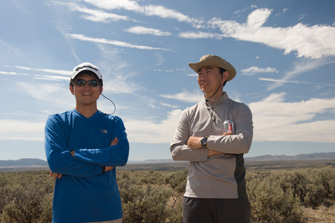
...At the end, let me share you a little trivial episode. Here in Houston, we have a jinx that every restaurant liked by Mr. Yui and me would go out of business after a while (sweat drop).
We were surprised to see various business establishments go out of business: ranging from a Thai restaurant, an Indian restaurant, a sandwich store, and a Chinese restaurant, and even to a batting center we frequented. Should you be operating a business, please beware if we two start frequenting it.
* Photos are by courtesy of JAXA.

Hello, everyone. I am freshman astronaut Norishige Kanai.
My "ascetic" training as astronaut on the road is still going on.
Time flies. As many as about three long years have already passed since I was selected as an astronaut candidate, after which, I have been undergoing training in various countries while being based on Houston, Texas, USA.
Although each training I take part in at whatever location in any country is always a part of one same project, the International Space Station project, it is interesting to me that I feel different national characteristics in terms of the way of training and the atmosphere of the training place peculiar to each training location.
When I am in Russia, for example, there is a long history of manned-flight space development by the country and I feel the country's great pride of "we Russians are taking the leadership in the operation of the ISS." But toward foreigners, there is no exclusiveness or unfriendliness at all. Rather, I even feel a kind of "great-heartedness" and "skillfulness in reception and support" with which to welcome people from outside of the country to learn technology and gain knowledge. I wonder if it comes from the historical background of Russia which, in the era of the former Soviet Union, accepted astronauts from socialist countries and let them have spaceflights, and invited private citizens for space travelling.
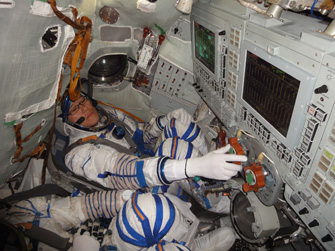
Scene of training on the Soyuz spacecraft in Russia (Source of photo: JAXA/GCTC)
An old well-known instructor who would know the era of Gagarin gave us instructions with full of human touch. Having actually undergone training under his instruction, I felt some emotional ties just like a "master and disciple" relationship commonly referred to in Japan. I feel a strong gratitude toward him for teaching me the ABC's of manned space activity kindly and sympathetically despite my poor Russian.
In the USA, by contrast, there are many younger and highly competent engineers among instructors, and the training system is designed in such a manner that trainees can acquire necessary and sufficient knowledge and skills efficiently within a short period of time.
In addition, various kinds of training methods are offered with which closeness to the reality has been pursued to the utmost. For example: NASA owns many trainer jet airplanes dubbed T-38 which is specifically operated for the purpose of flight training of astronauts; a life-size mock-up of the space station is submerged in water in a huge pool so that astronauts can practice a "spacewalk" in pressurized suits that have been adapted to underwater activities; and a real-size mock-up that imitates even to the minutest details inside of the space station (which is different from the one submerged in the pool) is prepared in the Space Center so that training shall be conducted there for replacing and repairing out-of-order pieces of equipment and for taking measures in emergency situations. I am very much concerned about how huge a budget is spend for just maintaining these facilities, though I know it's none of my business I cannot help but take my hat off to the USA about this, saying "This is what the superpower America is."
I think that, not only the nation's great power but also the national citizens' understanding and expectation on space development and the pride that the nation has brought human to the moon are allowing NASA that much room of activities.
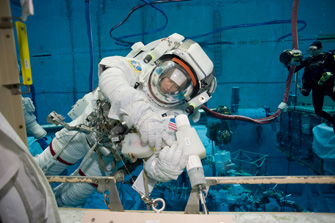
Scene of extravehicular activity training in NASA's pool (Source of photo: JAXA/NASA)
On the other side of the Atlantic, the European Space Agency is a relatively small organization operated by European countries with its budget shared among themselves. It was impressive to me that astronauts as well as staff members having backgrounds of different languages, different histories, and different cultures were working in cooperation toward a single objective. As seen from Japan, Europe seems to be one monolithic union. But when I put myself in Europe, I see differences in space policy from country to country, and it seems to be quite difficult to forge agreement among the countries on planning and budget.
Taking a look at the control center of the Space Station, its facilities are spread all over Europe, with its laboratory module "Columbus" located in Germany, with its transfer vehicle "ATV" located in France, and with the special facilities for respective experiment equipment installed in" Columbus" located in various countries and areas. And such facilities are sophisticatedly integrated into one organization via communication networking. I thought this is one of Europe's major characteristics.
Among countries that differ not only in language and thought but even in what goal to achieve, coordination is carried out time after time patiently to accumulate achievements one by one, in which I see how matured cosmopolitans backed by their long history should be. There is a lot to learn for me in it as a Japanese in an insular nation which has limited relations with foreign countries.
When working together with a newly-acquainted person, some may think it undesirable to judge what kind of personality he/she may have just stereotypically based on his/her nationality. But for a freshman like me, such judgment may be of some help as a material for starting conversation.
Today's space development, not limited to the Space Station, cannot do without multilateral international cooperation. In such international cooperation activities, I think it important not only to speak up with one's opinion, but also to understand different situations and thought of each other so as to create win-win relationships.
I think what is particularly important for such mutual understanding, above anything else, is to have a talk face to face.
I believe that nothing else but trying to understand unfamiliar cultures by knowing little things about it, starting from how to perform tasks, how to carry out training, and how to drink alcohol, shall be a first step toward achieving a big task.
In that sense, I really had meaningful experiences of visiting various ISS-related facilities to undergo training, and getting acquainted with the local instructors, engineers, and astronauts.
Although I am still inadequate both as an astronaut and as a JAXA employee, I consider that not only improving my expertise and technical knowledge but also accumulating my experiences and knowledge through meeting various people in various locales may be part of my "ascetic training" as an astronaut.

















The CAVES in which I participated was training where six astronauts and cosmonauts survived a week underground without sunlight, and with limited support from the ground.
The venue was the calcareous cave on the island of Sardinia, Italy, in the Mediterranean. Rather than a scenic sightseeing spot at ground level, it was a gigantic underground cave which resembled what you see on Mars or asteroids. It was also not only horizontal but vertical, and going up and down the tunnel and surveying underground tributaries, I felt as if we were exploring a different world.
With helpful support from local geologists and climbers, astronauts and cosmonauts from the U.S., Russia, Norway, Canada, and Japan collaborated and successfully completed a simulated asteroid exploration mission for the future. The training helped me because I had the opportunity to take on the role of Commander to coordinate young astronauts. I will utilize the experience for the next ISS long-duration mission, and even moon and asteroid exploration.